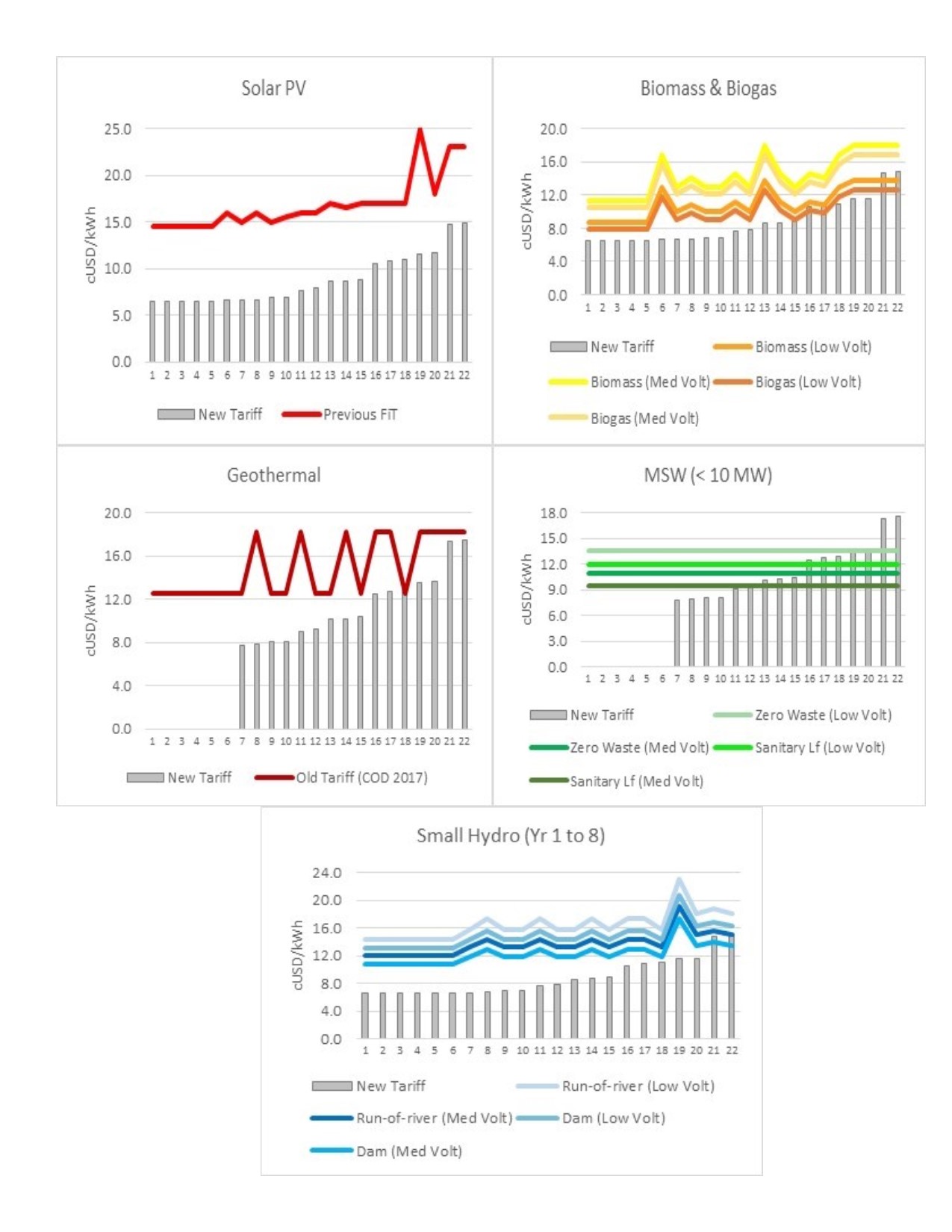Menu
Within six months since the announcement of the last tariff-related decree on power purchase from solar photovoltaic (PV) generators, the Ministry of Energy and Mineral Resources (MEMR), Indonesia introduced the MEMR Regulation No. 12/2017 on the Utilisation of Renewable Energy Resources for Electricity Supply. The new regulation covers power purchase from all existing renewable energy (RE) types such as solar PV, wind, hydropower, biomass, biogas, municipal waste, and geothermal. It uses the regional PLN’s (National Utility Company) main cost electricity supply (biaya penyediaan pokok/BPP) as its new reference price and obligates PLN to purchase power from RE plants. Currently, most power plants in Indonesia are using fossil fuels (mainly cheap coal and gas) which have been dragging BPP price down.
| RE Type | Purchasing Method | Tariff | |
| Regional BPP > National BPP | Regional BPP ≤ National BPP | ||
| Solar PV | Auction based on award capacity | Maximum 85% x regional BPP | 100% x regional BPP |
| Wind | Auction based on award capacity | Maximum 85% x regional BPP | 100% x regional BPP |
| Hydro | Reference Price | Maximum 85% x regional BPP | 100% x regional BPP |
| Direct Selection | Price determined by direct selection process | ||
| Biomass | Reference Price (for ≤ 10MW) | Maximum 85% x regional BPP | 100% x regional BPP |
| Direct Selection (for > 10MW) | Price determined by direct selection process | ||
| Biogas | Reference Price (for ≤ 10MW) | Maximum 85% x regional BPP | 100% x regional BPP |
| Direct Selection (for > 10MW) | Price determined by direct selection process | ||
| MSW | Reference Price | Maximum 100% x regional BPP | Mutual agreement |
| Geothermal | Reference Price | Maximum 100% x regional BPP | Mutual agreement |
The electricity costs from most renewable technologies in Indonesia are relatively higher than the local BPP, specifically in Java and Bali where more than 70% of the country’s total installed capacity exists. This has driven PLN to be fairly reluctant in purchasing RE from independent power producers (IPPs). Bringing down the RE price to less than the BPP is expected to push PLN to utilise as much as RE-generated power. The new regulation aims to support the government in achieving 23% of RE share target in the national energy mix by 2025. Moreover, aligned with the direction from the Minister of Energy and Mineral Resources, Mr Ignatius Jonan, to provide the people with the most affordable electricity, this substantial adjustment on electricity pricing is crucial to lowering the existing BPP at the associated local grids.
 Figure 1. LCOE 2014 Prices and Audited 2016 BPP Numbers at Rp13,307/USD
Figure 1. LCOE 2014 Prices and Audited 2016 BPP Numbers at Rp13,307/USD
As shown in the graph above, eastern Indonesia has relatively higher BPP compared to other areas, which leads them to have higher reference price as well. The new regulation is considered as one of the Government’s efforts to bring more RE investment and to have a more balanced development of infrastructures in Indonesia. This could also be the answer to the Minister’s concern over Indonesia’s affordability disparity and low electrification rate in the eastern part of the country.

Figure 2. Old & New Tariff Comparison by Technology. The axis follows Figure 1.
The new decree results in the most significant drop in solar PV technology with more than 50% tariff reduction from the previous feed-in-tariff (FiT). Meanwhile, tariff increases arise in Maluku and East Nusa Tenggara for municipal solid waste up to 10 MW, biomass and biogas due to its currently highest BPP. The significant tariff reduction also happens to small hydro plants due to their previous high price during its 1st to 8th year of the project period.
More than 80% of the probable and proven geothermal reserve exists in the region where the local BPP is lower than the average national (West Java, Central Java, Lampung, and Jambi). Therefore, most of the electricity from future geothermal projects will be priced by mutual agreement instead of its reference price.
Despite the generally decreasing RE tariff from the new regulation, Indonesia’s commitment on RE share still needs to be realised. This is not just the Government’s task, but also the responsibility of other stakeholders. As part of their efforts, the National Energy Council (DEN) gathered all stakeholders in a dialogue called “Indonesia’s Strategy to Achieve 23% RE Share Target” (Jakarta, 2 March 2017). The Dialogue was attended by experts from Directorate General of New RE and Energy Conservation, Directorate General of Electricity, PLN, and the Indonesian RE Society. As a follow-up on the new regulation, DEN proposed for more innovations in government’s incentives for the IPPs, to keep Indonesia’s RE climate attractive for investors and project developers. (featured photo credit: https://energy.gov/eere/femp/renewable-energy-technologies-federal-projects)
References
